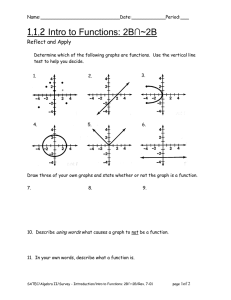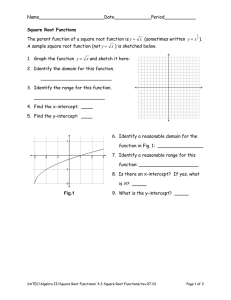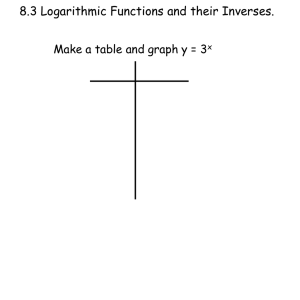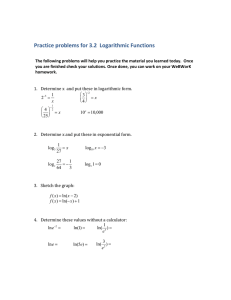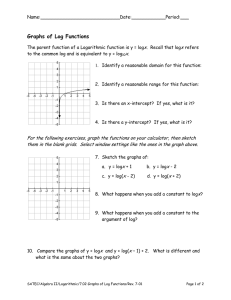7.1 Intro to Logarithmic Functions
advertisement
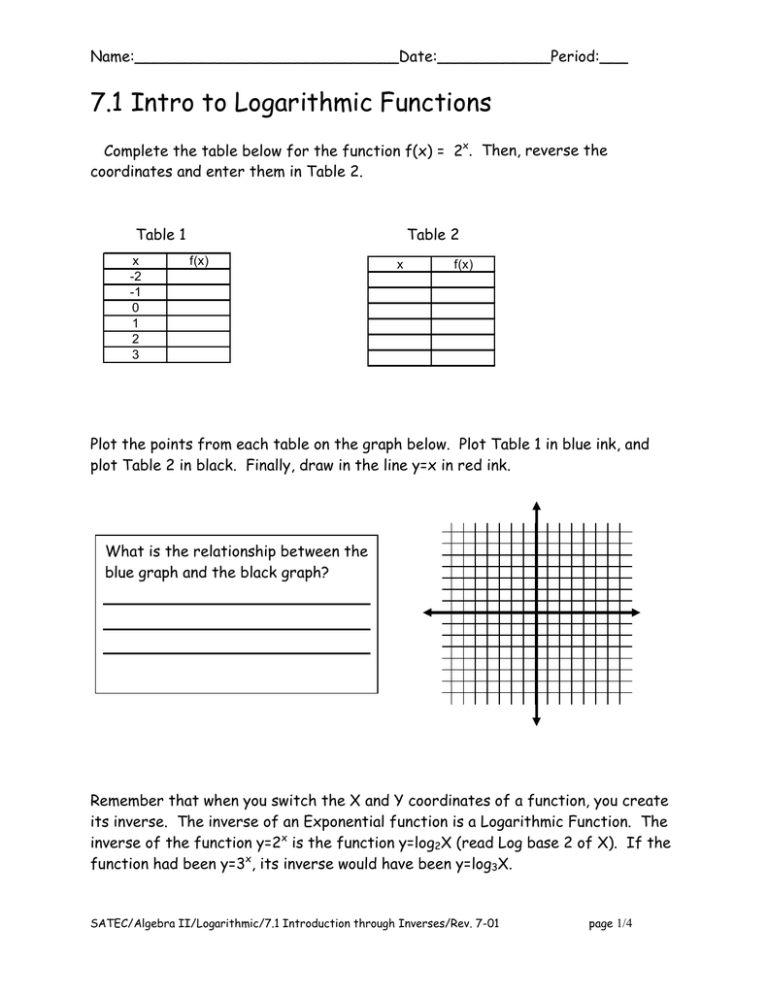
Name:____________________________Date:____________Period:___ 7.1 Intro to Logarithmic Functions Complete the table below for the function f(x) = 2x. Then, reverse the coordinates and enter them in Table 2. Table 1 x -2 -1 0 1 2 3 Table 2 f(x) x f(x) Plot the points from each table on the graph below. Plot Table 1 in blue ink, and plot Table 2 in black. Finally, draw in the line y=x in red ink. What is the relationship between the blue graph and the black graph? Remember that when you switch the X and Y coordinates of a function, you create its inverse. The inverse of an Exponential function is a Logarithmic Function. The inverse of the function y=2x is the function y=log2X (read Log base 2 of X). If the function had been y=3x, its inverse would have been y=log3X. SATEC/Algebra II/Logarithmic/7.1 Introduction through Inverses/Rev. 7-01 page 1/4 Find the value of each log: Exponential Form Logarithmic Form 2x=8 2x=16 2x=1 2x=1/2 2x=N log28 = ______ log216 = ______ log21 = ______ log2 (1/2) = ______ log2N = ______ means means means means means What number can the base of a logarithm not be?________ Why not? _______________________ _______________________ _______________________ Definition of Logarithm: ≠ 1 ), log b N=k if and only if bk=N. If b and N are positive numbers Log(bFunctions The base that your calculator uses is base 10. When you see y=log X, it is assumed that you are using base 10. This is what it known as the Common Log. Rewrite y = log X using exponential notation.___________________________ The parent function of a Logarithmic function is y = log x . A sample Logarithmic function (not necessarily y = log x exactly) is sketched below. 1. Identify a reasonable domain for this function: 2. Identify a reasonable range for this function: 3. Is there an X-intercept? If yes, what is it? 4. Is there a Y-intercept? If yes, what is it? SATEC/Algebra II/Logarithmic/7.1 Introduction through Inverses/Rev. 7-01 page 2/4 5. Graph the function y = log x and sketch it below (use a couple of specific points). 6. Identify the domain for this function. 7. Identify the range for this function. 8. Does the function ever cross the x - axis? If yes, identify the x-intercept. 9. Does the function ever cross the y-axis? If yes, identify the y-intercept. 10. Sketch the graphs of: a. y = logx + 1 b. y = logx − 2 d. y = log(x + 2) c. y = log(x − 2) 11. Now compare the graphs of y = logx and y = log(x − 1) + 2 . What is different and what is the same about the two graphs? 12. Now sketch the graphs of: a. y=2log(x) b. y=.5log(x) c. y=-log(x) 13. What does putting multiplying by a negative do to the graph? 14. Write the equation of a graph that is a reduction of the graph of y= log(x) by a factor of .5. SATEC/Algebra II/Logarithmic/7.1 Introduction through Inverses/Rev. 7-01 page 3/4 15. Write the equation of a graph that is an enlargement of the graph of y=log(x) by a factor of 5. SATEC/Algebra II/Logarithmic/7.1 Introduction through Inverses/Rev. 7-01 page 4/4
